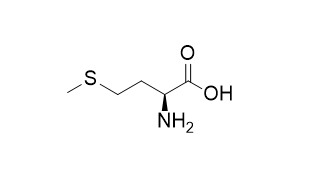L-Methionine
L-Methionine is marker of cell viability and estimating proliferative activity. L-Methionine and L-cystine can improve hyperlipidemia by restoring LPL and HSL activities, it also might be a new potential drug for Parkinson's disease treatment.
Inquire / Order:
manager@chemfaces.com
Technical Inquiries:
service@chemfaces.com
Tel:
+86-27-84237783
Fax:
+86-27-84254680
Address:
1 Building, No. 83, CheCheng Rd., Wuhan Economic and Technological Development Zone, Wuhan, Hubei 430056, PRC
Providing storage is as stated on the product vial and the vial is kept tightly sealed, the product can be stored for up to
24 months(2-8C).
Wherever possible, you should prepare and use solutions on the same day. However, if you need to make up stock solutions in advance, we recommend that you store the solution as aliquots in tightly sealed vials at -20C. Generally, these will be useable for up to two weeks. Before use, and prior to opening the vial we recommend that you allow your product to equilibrate to room temperature for at least 1 hour.
Need more advice on solubility, usage and handling? Please email to: service@chemfaces.com
The packaging of the product may have turned upside down during transportation, resulting in the natural compounds adhering to the neck or cap of the vial. take the vial out of its packaging and gently shake to let the compounds fall to the bottom of the vial. for liquid products, centrifuge at 200-500 RPM to gather the liquid at the bottom of the vial. try to avoid loss or contamination during handling.
Onco Targets Ther.2017, 10:3467-3474
J Agric Food Chem.2024, acs.jafc.4c01387.
Food Science and Biotechnology2022, 10.1007.
J Cosmet Dermatol.2022, 21(1):396-402.
Nutrients.2017, 10(1)
Biomedicines.2020, 8(11):486.
Mol Med Rep.2014, 9(5):1653-9
Hindawi J of Food Biochemistry2023, P17:8883860
Processes2021, 9(5),831.
Int J Mol Sci.2021, 22(8):4211.
Related and Featured Products
Journal of Nuclear Medicine Official Publication Society of Nuclear Medicine, 1995, 36(2):252.
In vitro comparison of cell proliferation kinetics and uptake of tritiated fluorodeoxyglucose and L-methionine in squamous-cell carcinoma of the head and neck.[Reference:
WebLink]
Estimation of tumor proliferative activity is important for the optimal management of head and neck cancer. Noninvasive metabolic imaging with PET may complement currently used cytopathologic methods to study tumor proliferation.
METHODS AND RESULTS:
Fluorodeoxyglucose (FDG) and L-Methionine (MET) were studied for their potential to assess in vitro the growth characteristics of three squamous-cell carcinoma (SCC) cell lines established recently in patients with head and neck cancer. A time-course uptake of tritiated FDG and MET was measured over the complete growth cycle of one rapidly growing (UT-SCC-5) and two relatively slower growing (UT-SCC-1A and UT-SCC-9) cell lines. DNA flow cytometry was used for assessment of proliferative activity. There was a strong linear relationship for both FDG and MET uptake versus the viable cell number although absolute MET uptake was consistently lower than that of FDG in the exponential and plateau phases of growth (p < 0.01), leading MET to underestimate cell number. The pattern of MET uptake followed the flow cytometric changes in the proliferation index (% of S + G2/M cells) in two of three cases (UT-SCC-1A and UT-SCC-5) while a similar, although clearly weaker, relationship was seen with FDG and flow cytometry findings in only one case (UT-SCC-5).
CONCLUSIONS:
In these three human SCC cell lines assessed in vitro, FDG is a better marker of cell viability than MET, whereas MET is superior for estimating proliferative activity. Extrapolations of these in vitro data to the interpretation of PET images should be made with caution since tumors may have confounding factors that may affect in vivo tracer uptake.
Cytotechnology, 2010, 62(3):225-233.
Effects of sulfur amino acids, L-methionine, L-cystine and L-cysteine on lipoprotein lipase and hormone-sensitive lipase in differentiated mouse 3T3-L1 adipocytes.[Reference:
WebLink]
Rats subcutaneously implanted with AH109A hepatoma cells show hyperlipidemia with high concentrations of serum triglyceride and nonesterified fatty acid, suppression of lipoprotein lipase (LPL), and elevation of hormone-sensitive lipase (HSL) activities during the growth of the hepatoma. Supplementation of the diet with sulfur amino acids such as L-Methionine (Met) and L-cystine (Cys) improved hyperlipidemia by restoring LPL and HSL activities.
METHODS AND RESULTS:
In the present study, we have attempted to examine the effects of sulfur amino acids on the activity and mRNA level of LPL and the activity of HSL using 3T3-L1 cells, which are known to differentiate to adipocytes. The adipocytes were incubated with various concentrations of Met, Cys or L-cysteine (CysH) in the absence or presence of tumor necrosis factor-α (TNF-α). LPL activity was suppressed by TNF-α. In the absence of TNF-α, Met, Cys and CysH did not change the LPL activity. In the presence of TNF-α, Met and Cys significantly increased the LPL activity, and Met also enhanced the LPL mRNA level. HSL activity was also suppressed by TNF-α. In the absence of TNF-α, Met enhanced the HSL activity.
In the presence of TNF-α, Met, Cys and CysH suppressed the HSL activity. Sulfur amino acids such as Met, Cys and CysH affected the LPL activity, mRNA level, and HSL activity in 3T3-L1 adipocytes.
CONCLUSIONS:
Some of these effects of sulfur amino acids were different between LPL and HSL, between the absence and the presence of TNF-α, and between 3T3-L1 adipocytes and the adipose tissue from rats.
Life Sciences, 1983, 32(20):2321-2328.
A subacute treatment of L-methionine induces an increase in the number of [3H]spiperone binding sites in the striatum of the rat.[Reference:
WebLink]
METHODS AND RESULTS:
A subacute treatment, 500 mg/kg I.P. twice daily during 5 days, by L-Methionine provoked an increase in the B max of [ 3H]-spiperone binding in the striatum of the rat. This increase was associated to a decrease in membrane microviscosity. However in these conditions no changes were found in the [ 3H]-DHA, [ 3H]QNB bindings or in the brain dopamine sensitive adenylate cyclase activity.
L-Methionine treatment reduced the accumulation of Dopa after NSD 1015 and antagonized the decrease in striatal acetylcholine provoked by haloperidol.
CONCLUSIONS:
Thus L-Methionine might be a new potential drug for Parkinson's disease treatment.



